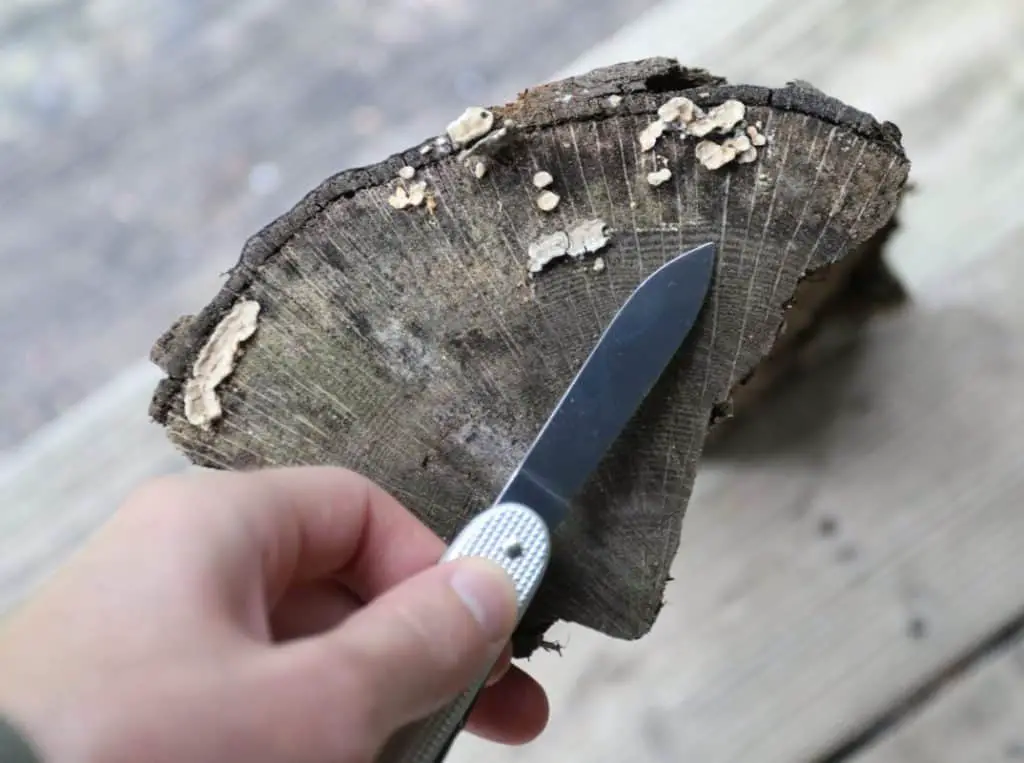
There are clear benefits to some types of firewood over others, but if you don’t know how to identify firewood then it won’t do you any good.
Without the ability to consistently identify common types of firewood, you won’t be able to intentionally select firewood for your wood stove or campfire.
The good news is, that with a few simple techniques, you’ll be able to identify many of the most common firewood species’.
In this guide, you’ll find 3 overall techniques for identifying firewood, plus straightforward tips for recognizing 10 of the most common firewood types (Note: these species are common in my area, the Midwest USA). Let’s go!
You can use the jump links below to skip to the types of wood you’re interested in identifying:
4 Methods for Identifying Firewood
Before we look at tips for identifying individual species’ of firewood, let’s begin with a quick overview of the primary methods you can use to identify firewood.
Using the End Grain
First, you can use the characteristics of the end grain to identify firewood. This method is often used by foresters because it tends to be more accurate than using the bark, leaves, etc..
However, to see the finer details of the grain, foresters often use a hand-lens. Since the average person is not going to carry a hand-lens, this method is usually only helpful for certain types of wood with very distinctive end-grain traits: like Oak and Elm.
For example, Elm has wavy rings on the end grain, which is a characteristic that NO OTHER type of wood has. This makes it very easy to pick out from a pile of other wood.
Using the Bark
The bark is probably my favorite tool for identifying firewood. Split firewood often still has bark attached, plus different types of firewood often have fairly distinctive bark patterns.
For example, Shagbark hickory has extremely flaky bark that is easy to pick out from other types of wood.
The downside of this method is that sometimes the bark will fall off of split firewood. Plus, as the bark dries (or decays) it can become more difficult to identify. However, overall bark is a great approach for identifying firewood.
Using the Color
Color is sometimes helpful and sometimes unhelpful for identifying firewood. Color can be a great approach for wood like Cherry, or Mulberry, which have unique coloration.
However, many types of wood are light brown in color, and the color of wood does change as it dries and is exposed to sunshine. So, this approach can be good but is not always reliable.
Using the Leaves
Using leaves is the classic approach for identifying wood and trees, and it’s the method most people learn first. The tricky thing about using leaves is that you may not have any available when you’re at a firewood pile.
But, if you do have leaves available, it can be a great tool for identifying the type of wood you’re looking at. Some of the easiest types of wood to identify using leaves are Maple and Oak.
Now that we’ve walked through some of the most common approaches for identifying firewood, we’ll jump into our favorite identification tricks for 10 of the most common firewood species here in the Midwest USA:
1. Identifying Pine Firewood
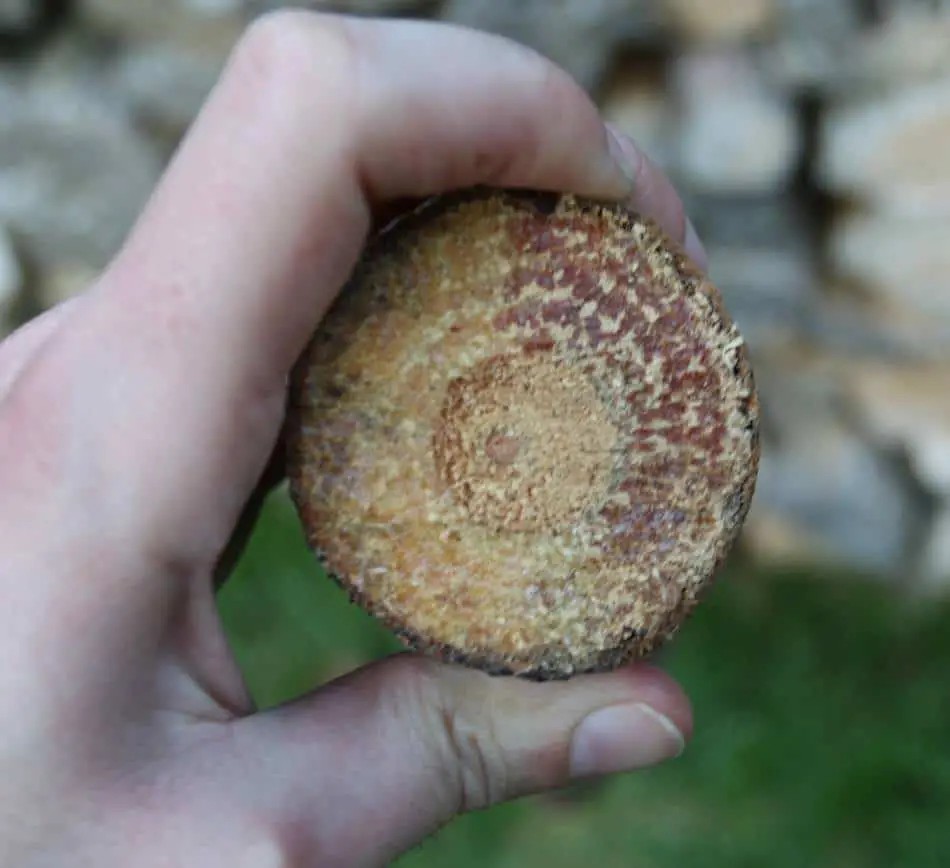
Using the End Grain
Pine is one of the easiest types of firewood to identify.
You can use the end-grain, or even just the sides of the wood, to check for sticky sap. If you pick-up a piece of wood that is sticky, then it’s almost definitely Pine.
Pine also tends to have a lot of branches and knots on the side.
Using the Leaves
Lastly, Pine doesn’t have leaves, but it does have needles. This distinction can be helpful because most other firewood trees do have leaves.

2. Identifying Oak Firewood

Using the End Grain
You can identify Oak firewood very easily using the end grain of the wood.
Take a look at the end grain of your piece of firewood. You should be able to see the normal annual rings that indicate how old the tree was.
In addition to the rings, Oak has clearly visible lines that run perpendicular to the rings, going straight outward from the center of the wood. I’m pointing to them with my pocket knife in the photo above.
These lines are called “rays”, and Oak is one of only two types of firewood (at least around here), that has rays that are visible to the naked eye.
The other type of firewood where you can see the rays is Sycamore, but the lines are much smaller and closer together. Plus it’s easy to identify Sycamore by the light white/green color of it’s bark.
So, if you find a piece of wood with rays, and it’s not Sycamore, then it’s got to be Oak.
Using the Leaves
If you happen to have a leaf on hand, you can also identify Oak using the leaves. For example, here’s an Oak leaf below:
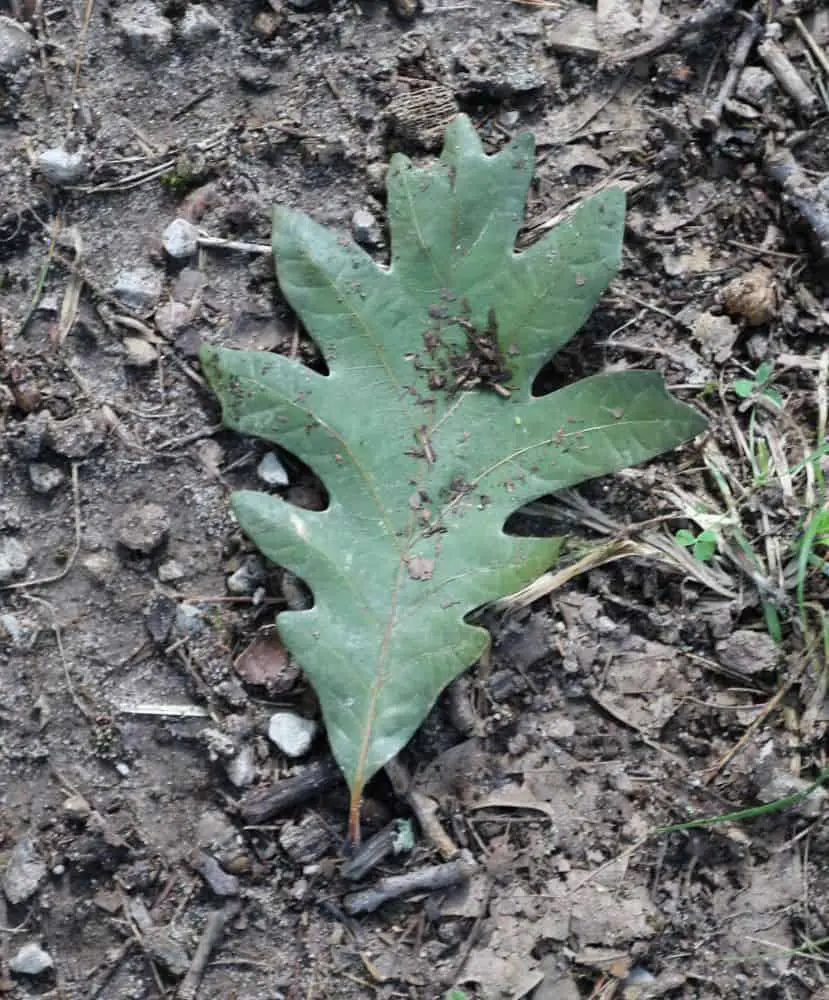
Oak leaves have a unique shape with 5-lobes, and they are also alternate-simple leaves.
For a leaf to be alternate, means that they grow on branches in an alternating pattern (e.g. left-right-left, etc.). For a leaf to be simple, means that each leaf contains only one leaf (simple) and is not a series of leaves stuck together (compound).
If you find a tree with leaves meeting these characteristics, then you’ve found yourself an Oak. Also, Oaks are the trees that produce acorns, so if you see any acorns, then you’re likely looking at an Oak tree.
3. Identifying Sycamore Firewood
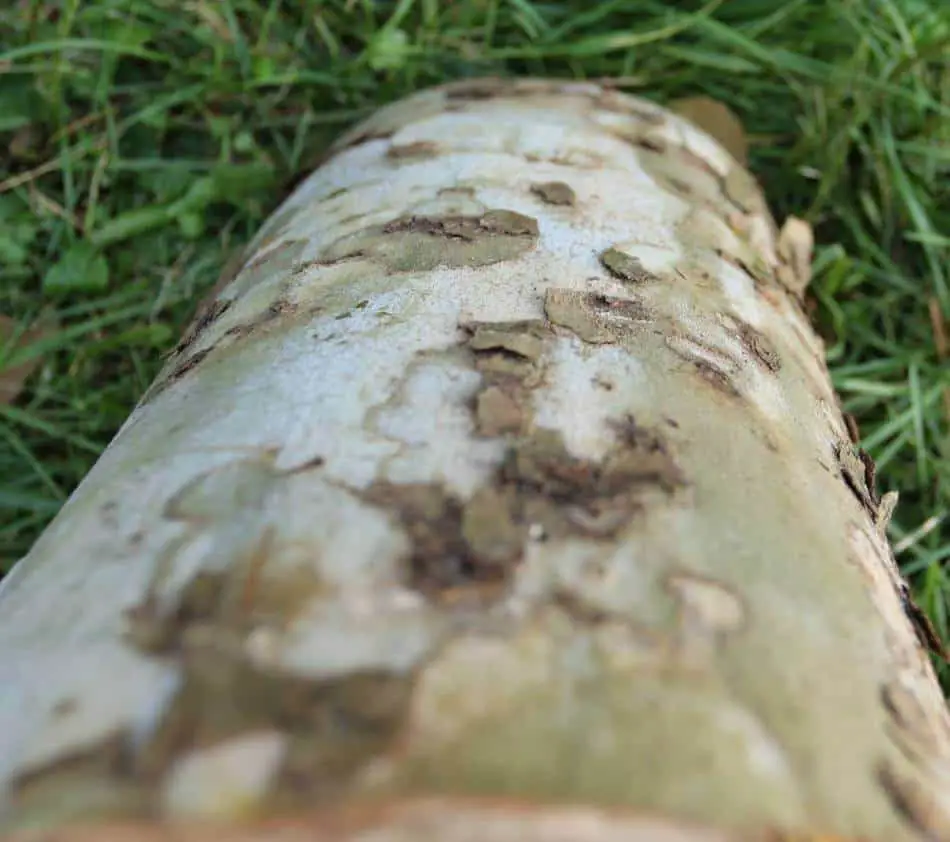
Using the Bark
Sycamore has a very distinctive bark that is easy to identify as firewood or when looking at a tree.
If you look at the photo above, you’ll see that Sycamore has flaky bark, and underneath the bark is an interesting whitish-green color. When you look at a piece of Sycamore the bark almost makes the wood look “naked”.
This “naked” appearance is most prominent at the end of branches, and at the top of the tree.
Using the Leaves
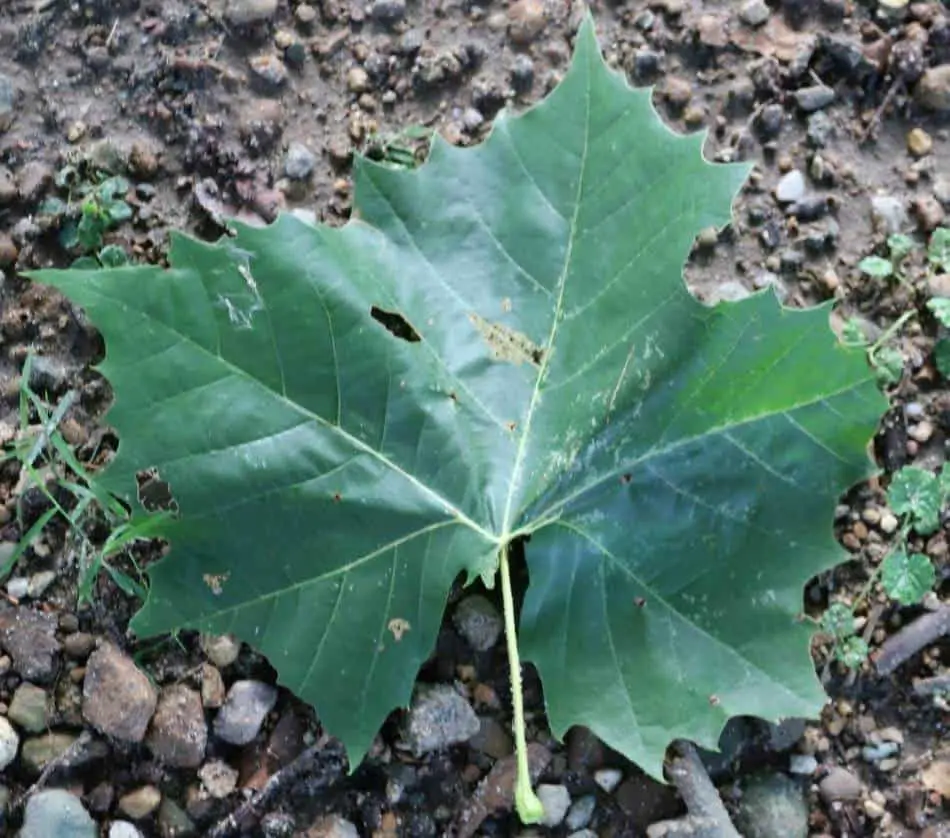
Lastly, Sycamore can also be easily identified using it’s leaves. So you’ve got a lot of options to confirm if you’re dealing with Sycamore 🙂
Sycamore leaves basically look like HUGE Maple leaves. The easiest way to pick them out from a group of other leaves, is their large size and shape.
If you want to get a bit more scientific, Sycamore leaves are “simple-alternate” which means they grow on branches in an alternating pattern (e.g. left-right-left), and each leaf grows individually (e.g. it is not a single leaflet in a larger compound leaf).
Using the End Grain
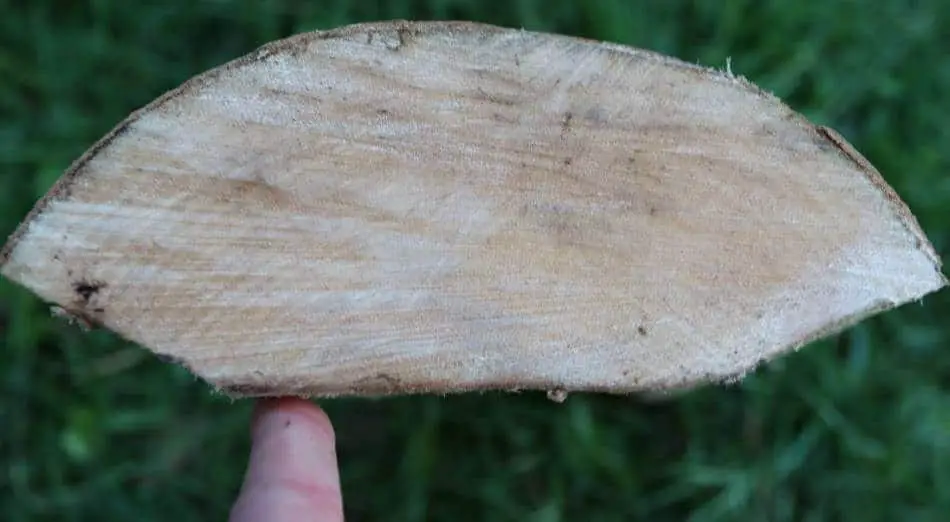
Sycamore and Oak are the only 2 species of firewood that have rays that can be seen with the naked eye. If you missed it in the Oak section above, rays are lines that run from the center of the wood to the outside.
However, it’s easy to tell Oak and Sycamore apart, because the rays on Sycamore are much smaller and closer together. In fact, you may not even be able to see them clearly from the photo above.
4. Identifying Elm Firewood
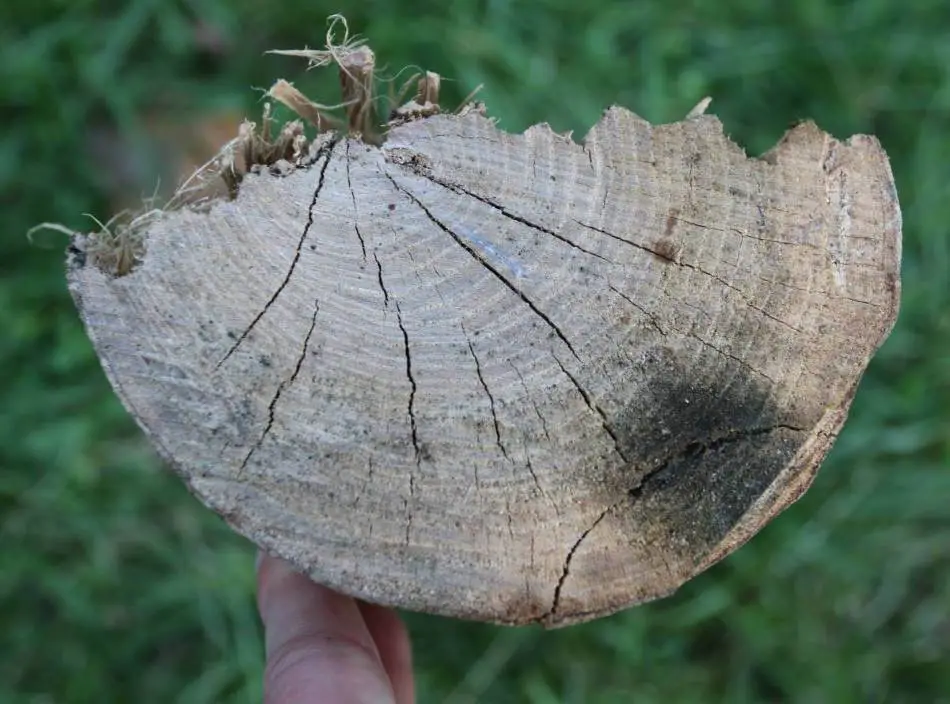
Using the End Grain
Elm and Oak are probably the only types of wood that I would recommend using the end grain as your first method for identification.
The reason for using the end grain to identify Elm is that it has a characteristic that no other type of firewood has: the annual rings are wavy.
For most types of wood, the lines of the annual rings are relatively uniform. But for Elm, the rings are wavy and almost look “blurry”. See the photo above to see what I mean.
Using the Leaves
I’d recommend always using the end grain to identify Elm, but you can use the leaves as a back-up plan.
Below is an image of a few Elm leaves. Elm leaves are alternate-simple, meaning they grow in a “left-right-left” pattern along branches, and each leaf is single (e.g. not part of a compound leaf).
As you can see in the photo, the edges of the leaves also look serrated. Plus, the bottom of the leaves may feel fuzzy, almost like a peach.
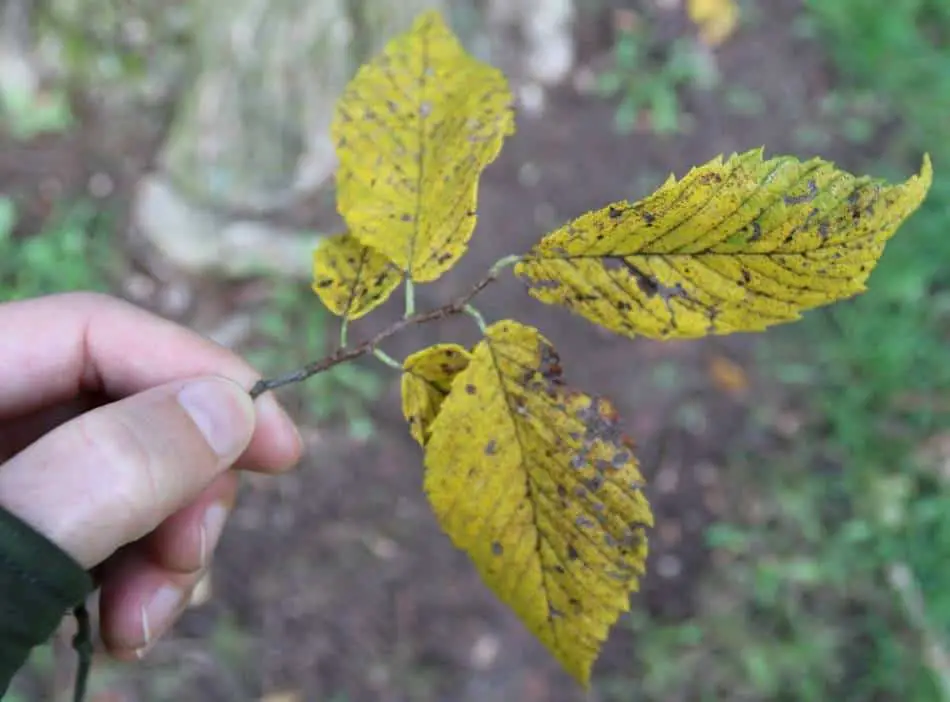
5. Identifying Cherry Firewood
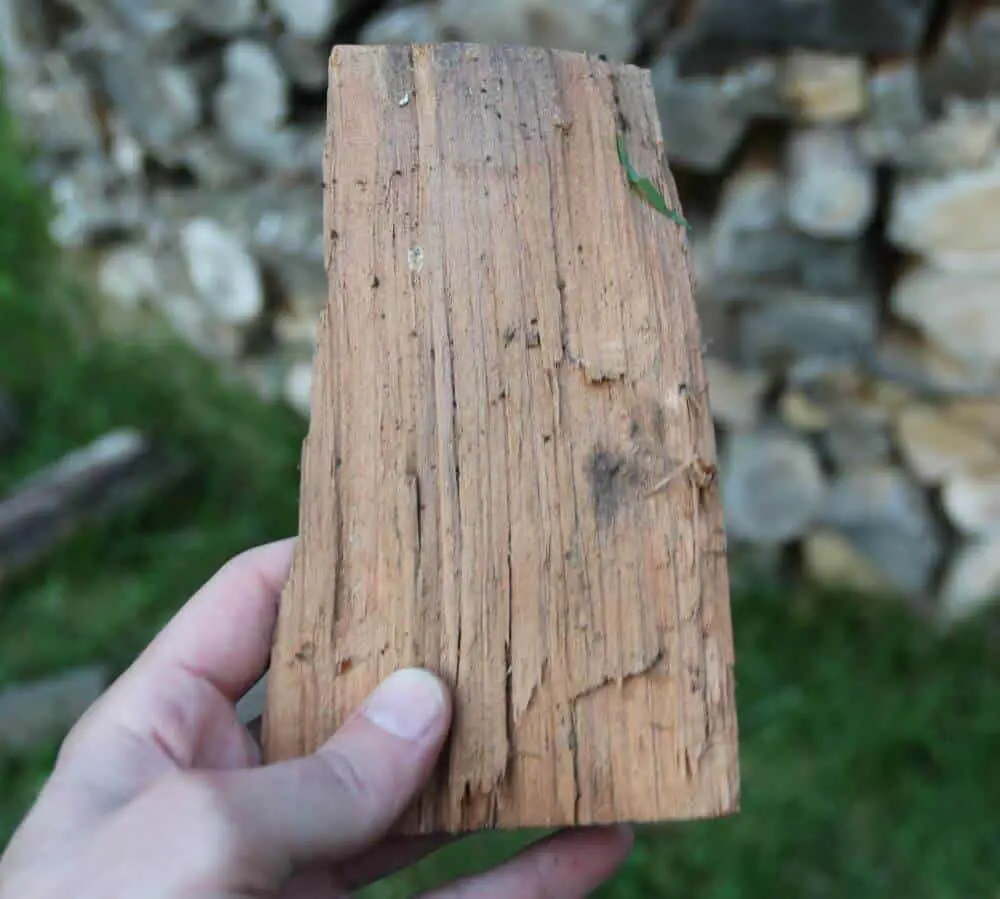
Using the Color
Most firewood has a light brown color, but Cherry has a light red color.
There are other types of firewood with some red color in the wood, like Mulberry. But Mulberry has red-colored heartwood (the center of the wood), and a white/brown colored sapwood (the outer ring of the wood).
You can tell that you have a piece of Cherry firewood if it’s consistently red throughout the wood.
I’ll admit, this is not a particularly scientific way to identify the wood, and color can shift as the wood is exposed to the elements. However, 9 times out of 10, you should be able to identify Cherry firewood by the color alone.
6. Identifying Mulberry Firewood
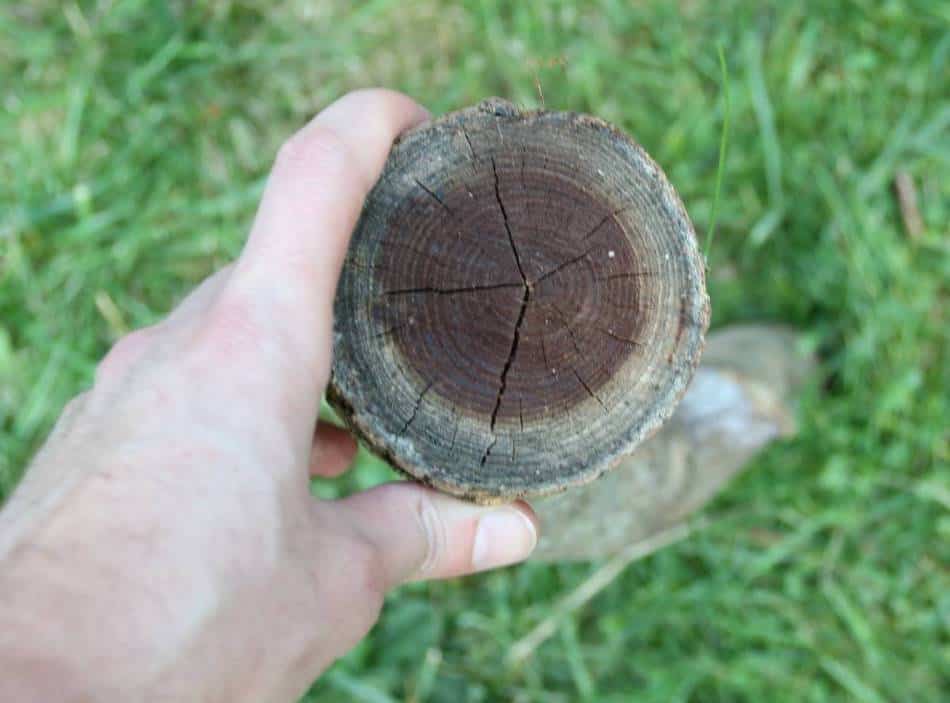
Using the Color
Mulberry is another species of firewood that is easiest to identify using color. For Mulberry, you are looking for a dark red heartwood (center of the wood) and a whitish sapwood (outer ring of the wood).
If you find a piece of wood with this color pattern, then you’ve found a piece of Mulberry. See the photo above for a clear example.
Another unique characteristic of Mulberry is the white streaks that it gets on the outside of the bark (often under branches). See the photo below for an example (note: this piece of wood is upside down).
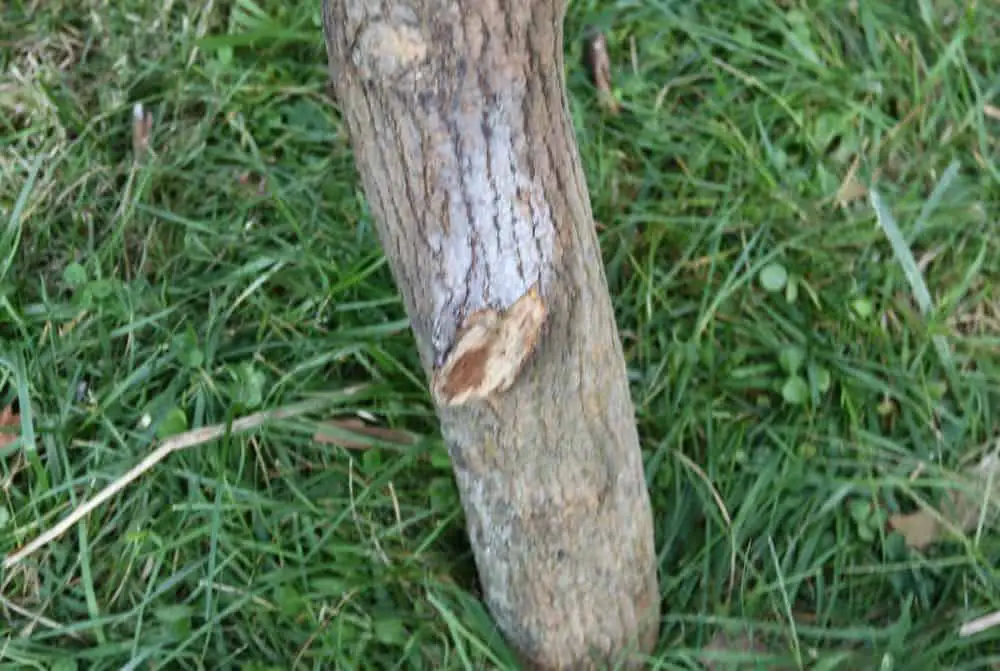
Using the Leaves
As a back-up, you can also identify Mulberry wood using leaves when they’re available. Mulberry trees have alternate-simple leaves.
This means they grow on branches in a left-right-left pattern, and grow as individual leaves (rather than leaflets attached to a larger “compound” leaf). They are also small in size and have jagged edges. See photo below.
If it’s the right time of year, you may also be able to spot their dark purple berries, which are quite delicious.

7. Identifying Maple Firewood

Using the Leaves
Maple leaves are the #1 most recognizable leaves in the world. They’re on the Canadian flag, bottles of Maple syrup, and other places.
As a result, the easiest way to identify Maple firewood is using the leaves.
However, when it comes to identifying firewood, leaves are not always available. So, let’s look at one alternative method as well:
Using the Bark
In the picture below, I’ve got a piece of Maple wood. And you may notice right away how “tight” the bark is. This piece of wood is from a branch, which is where this characteristic is most prominent.
But overall, Maple bark tends to be much more closed and “skin-like” compared to bark from other types of firewood.
For example, Ash has big parallel ridges in its bark that almost looks like small wooden mountain ranges. And Hickory has bark that grows in thin “plates” that sometimes hang or flake off (like with Shagbark Hickory).
So if there are no leaves available to identify a potential piece of Maple, I’d take a look at the bark next.
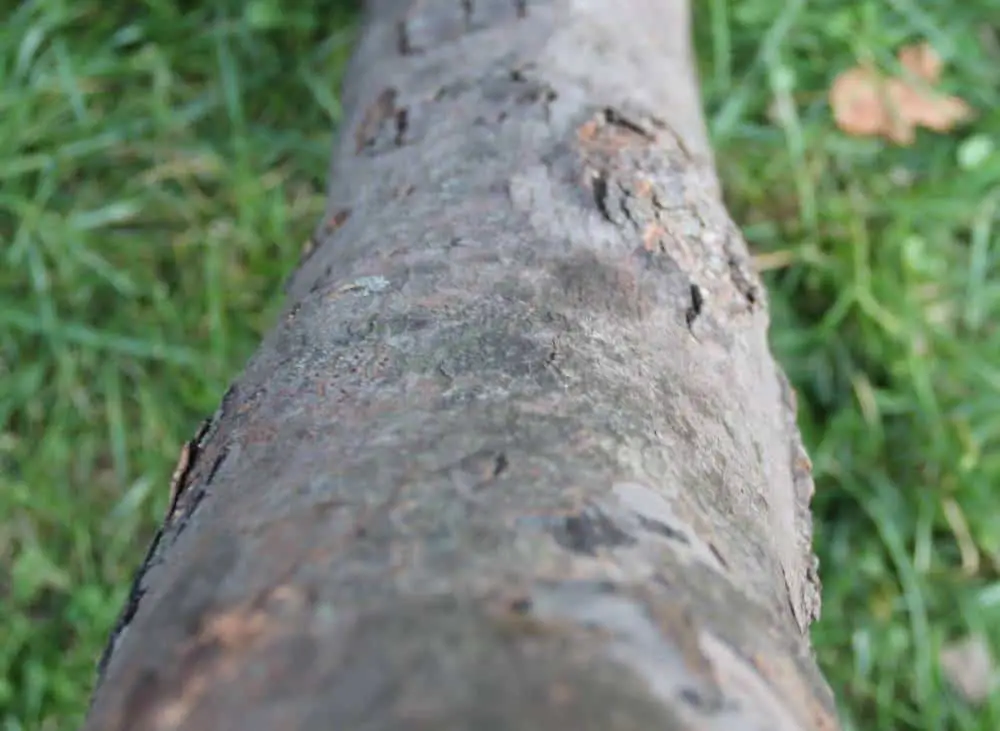
8. Identifying Hickory Firewood

Using the Bark
The easiest way to identify Hickory firewood, is using it’s very distinctive flaky bark. In the image above, you’ll see the bark of a Shagbark hickory tree, which gives a great example of this.
Not all types of Hickory have bark that hangs as freely as Shagbark does, but most still have bark that grows in flaky “sheets”. For example, you can see a piece of Pignut Hickory in the photo below.
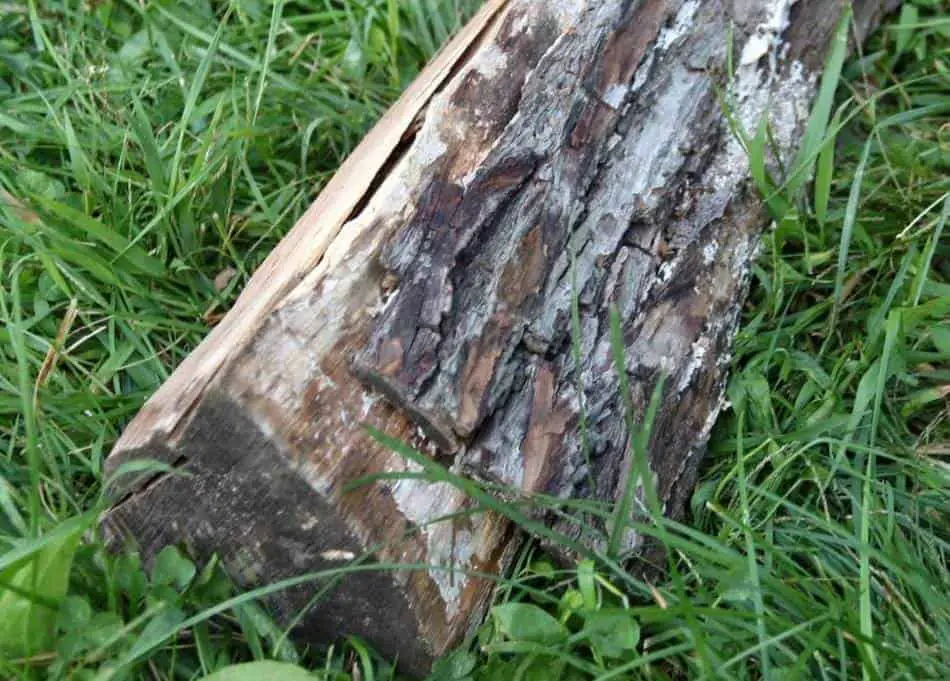
Using the Leaves

As a back-up to using the bark (which is the easiest method) you can also use the leaves to identify Hickory firewood.
Hickory produces compound leaves that typically have 7-9 leaflets (see the photo above). In appearance, they are somewhat similar to Ash leaves, but if you look at a branch with leaves on it you can see a difference.
For Hickory trees, the compound leaf stems grow down branches in an alternating pattern. Whereas for Ash trees, the compound leaf stems grow opposite to each other on the branches.
Another type of leaf that is similar to Hickory is Walnut. But Walnut trees typically have several more leaflets than Hickory does, so they should be pretty easy to distinguish.
In summary, if you find a tree that has compound leaves that grow in an alternating pattern, and it has 7-9 leaflets, then it’s probably going to be a Hickory tree.
9. Identifying Ash Firewood
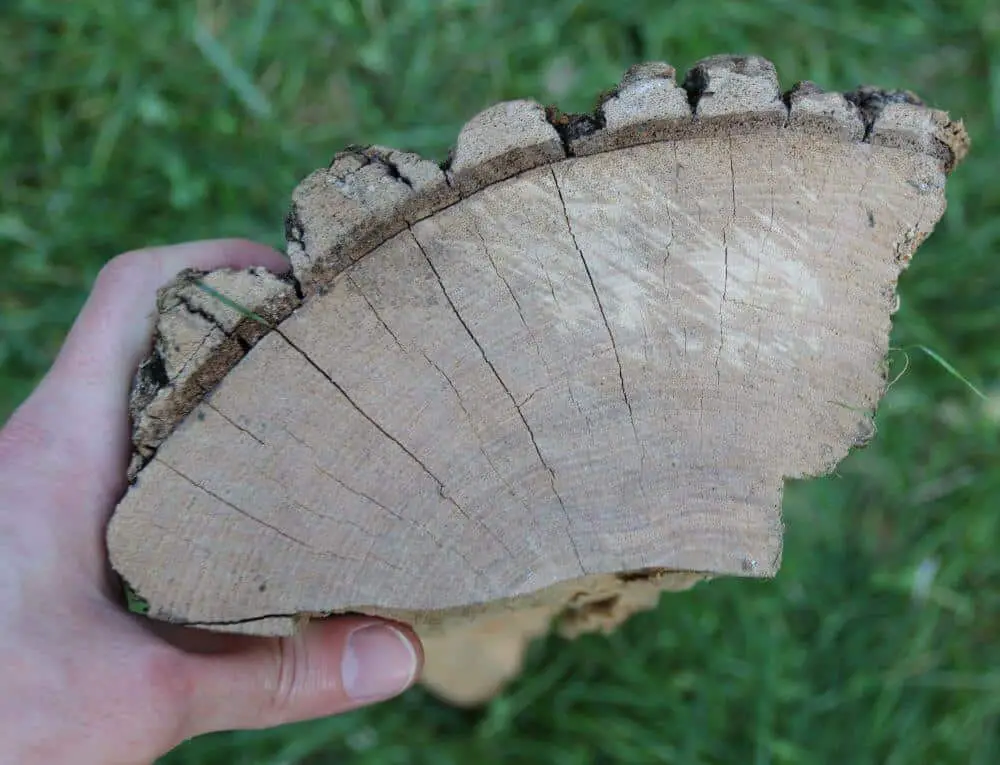
Using the Color
To identify Ash firewood, look for a light white/brown color that is consistent throughout the wood.
Most of the other types of firewood in this list will either have a darker color or will have different colored heartwood (center of the wood) and sapwood (outer ring of the wood).
Using the Bark
If the bark is still on, you can also use that as an indicator. On Ash, especially on larger trees, the bark forms in large parallel ridges. It looks kind of like tiny parallel mountain ranges.
This is different than Hickory, for example, which grows bark in a thin plated-pattern. Or Maple, which tends to have much tighter-fitting bark.
Using the Leaves
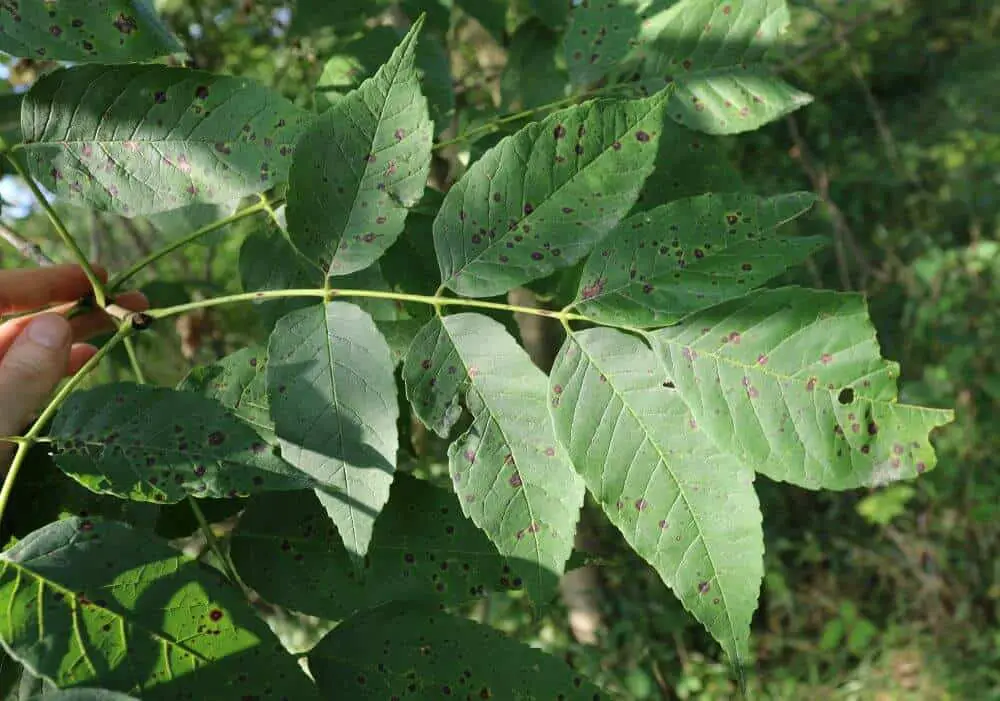
If the other two techniques don’t work for you, and if leaves are available, this can be a more accurate way of identifying Ash.
Ash has “opposite-compound” leaves. For a leaf to be opposite means that where one leaf grows, there is always another one growing in parallel (e.g. directly opposite) to it.
And for a leaf to be compound means that each bud from the tree grows a series (e.g. a chain) of leaves, instead of one single leaf (called a “simple” leaf).
In our area (Midwest USA), there are very few trees that have opposite-compound leaves. As an additional distinguishing characteristic, most types of Ash trees have 7-11 leaflets (the one in the image above has 7).
So, if you find a leaf that looks like the photo above, and it is opposite-compound with 7-11 leaflets, then you’ve found yourself an Ash leaf.
10. Identifying Black Locust Firewood
Using the Color
The easiest way to identify Black Locust firewood is using it’s bright yellow/brown color. But this only works for freshly cut logs, because the color fades as the wood dries.
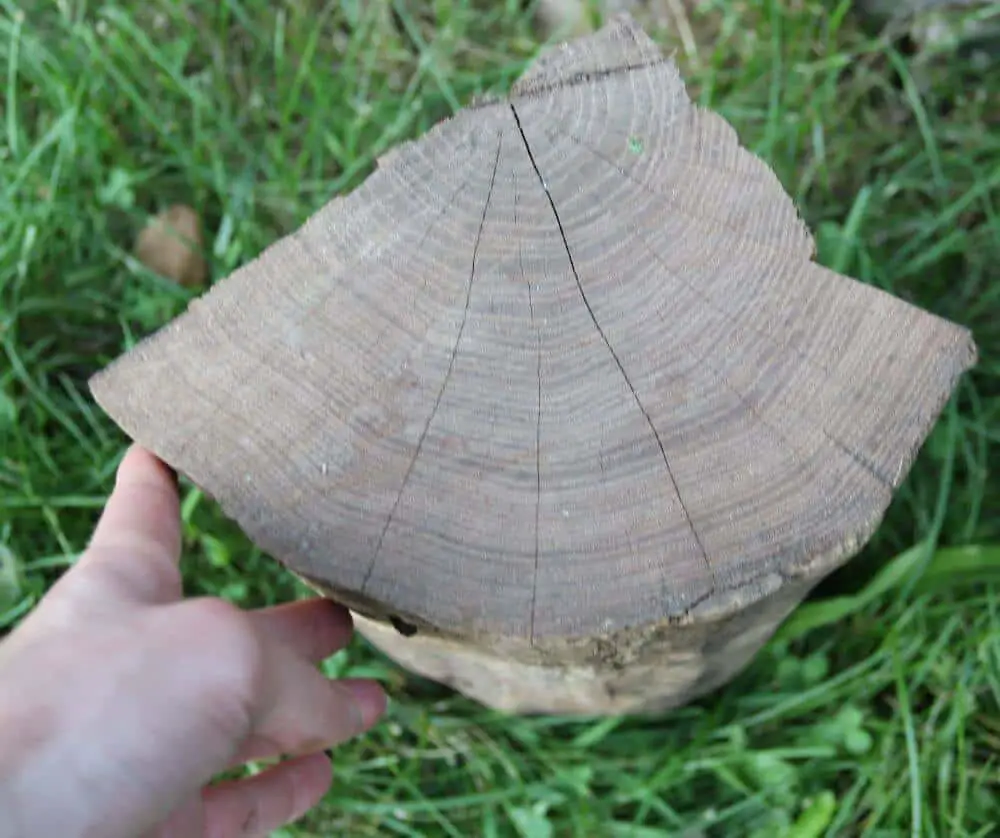
Using the Bark
If the wood is too dry to see the yellow color, then the next easiest method for identifying Black Locust is using the thorns (which I’m counting as part of the “bark” category).
Black Locust is one of only a few species of trees in our area (Midwest USA) that grow thorns directly from the tree. In Black Locust, these thorns often grow near the point from which it’s leaves sprout. See the image below:

So, if you’re looking at a branch and you can see thorns, then you’re down to a handful of potential options. Of these options, Black Locust is the most common (at least around here).
Plus, the other species’ should have different types of thorns. The moral of the story, is if you find a piece of wood with thorns like in the image above, then you probably have a piece of Black Locust.
Using the Leaves
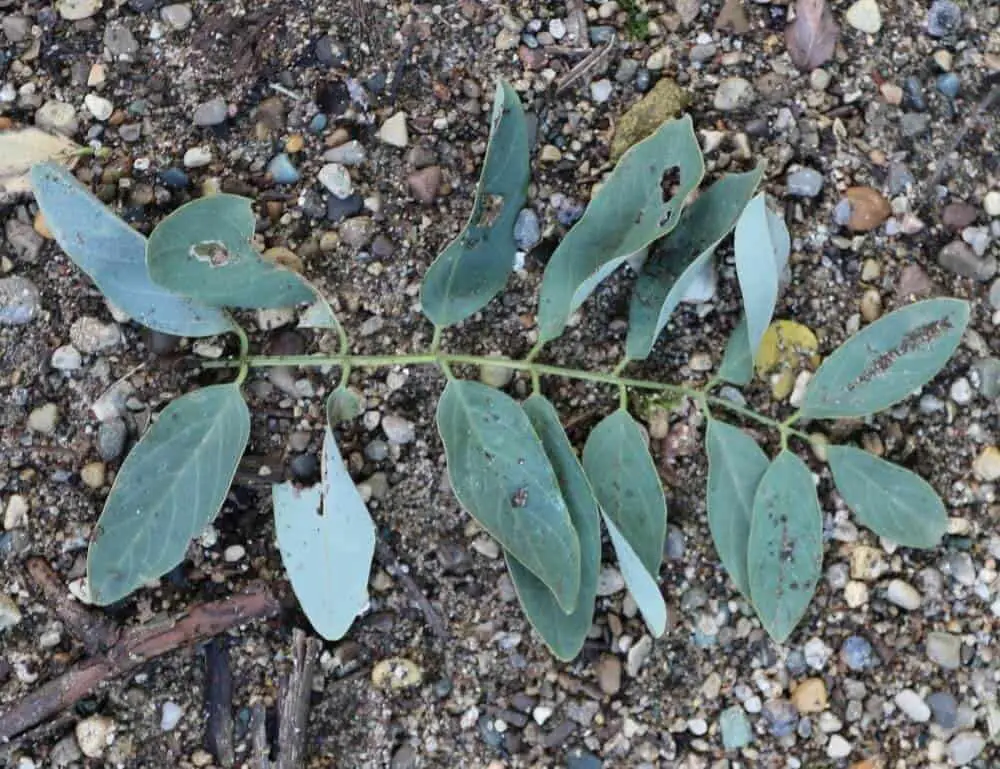
Lastly, if you’re not sure after using the above methods, you can still use the leaves to further identify the piece of wood you’re looking at.
Black Locust trees have alternate-compound leaves, which means that they grow down the branch in a left-right-left style pattern, AND each leaf is actually a chain of leaflets growing from a single bud off of the tree branch.
In addition to being alternate-compound, Black Locust leaves have a very high number of leaflets (anywhere from 9-19 per compound leaf).
Related Questions
What Type of Firewood Burns Longest?
The five longest-burning types of firewood in America are Osage Orange, Dogwood, Black Locust, Hickory, and Apple. When all conditions are equal, such as the moisture content and volume, the heaviest wood will typically burn the longest. And the five wood species’ mentioned above, are the densest in America.
How Do You Know if Wood Is Dry Enough to Burn?
The most accurate way to tell if wood is dry enough to burn is to use a moisture meter. If the moisture content of the firewood is below 20%, then it is thoroughly seasoned and can be burned. If you don’t want to use a tool, you can also use the weight, sound, and cracks on the wood to tell if it’s dry.
What is the Most Common Type of Firewood?
The most common type of firewood in America today is probably Oak or Pine. Ash was likely at the top a couple of decades ago, but the Ash population has been severely damaged by the Emerald Ash Borer. Oak is a common hardwood that’s great for heating, and Pine works well for outdoor campfires.
